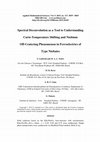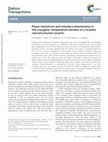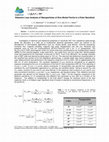Papers by Marcos A L Nobre

Molecules
Innovative composites based on an amorphous-carbon matrix containing a second phase ZnO oxide and... more Innovative composites based on an amorphous-carbon matrix containing a second phase ZnO oxide and/or highly dispersed Zn metallic were synthesized via a modified Pechini route, in which a partial pyrolysis method was reached. Studies of adsorption in the dark and the photocatalytic activity for the cationic azo-dye, basic blue 41, and degradation were carried out. X-ray diffraction patterns for the carbon matrix and its composite with Zn show characteristics of the amorphous carbon. The infrared in the mid region of the composite prepared with ZnO and Zn exhibit vibrational bands related to bonds zinc oxide. The surface pH of the material is the main factor responsible for the adsorption of the azo-dye, but the contribution of mesopores favored the diffusion of molecules from the bulk of solution to the pore framework. Esters-like functional groups on the surface of carbons hinder the adsorption of the azo-dye. When Zn is embedded within amorphous carbon the photocatalytic activity ...

Molecules
Nanoparticles of cerium oxide CeO2 are important nanomaterials with remarkable properties for use... more Nanoparticles of cerium oxide CeO2 are important nanomaterials with remarkable properties for use in both industrial and non-industrial fields. In a general way, doping of oxide nanometric with transition metals improves the properties of nanoparticles. In this study, nickel- doped cerium oxide nanoparticles were synthesized from Stevia rebaudiana extract. Both doped and non-doped nanoparticles were characterized by X-ray diffraction, Field Emission Scanning Electron Microscopy, Energy Dispersive X-ray, Raman spectroscopy, and Vibrating-Sample Magnetometry analysis. According to X-ray diffraction, Raman and Energy Dispersive X-ray crystalline and single phase of CeO2 and Ni doped CeO2 nanoparticles exhibiting fluorite structure with F2g mode were synthesized. Field Emission Scanning Electron Microscopy shows that CeO2 and Ni doped nanoparticles have spherical shape and sizes ranging of 8 to 10 nm. Ni doping of CeO2 results in an increasing of magnetic properties. The enhancement of ...

Green Chemistry Letters and Reviews
Grass waste was used for transform an inexpensive waste into health. Silver nanoparticles (AgNPs)... more Grass waste was used for transform an inexpensive waste into health. Silver nanoparticles (AgNPs) have been synthesized using waste material (dried grass). The average size of silver nanoparticles observed in transmission electron images was estimated to be about 15 nm. The anticancer, antifungal and antibacterial effect of AgNPs were studied in vitro. The minimum inhibitory concentration of AgNPs against Pseudomonas aeruginosa and Acinetobacter baumannii was calculated about 3 µg/ml. The highest level of inhibitory effect of AgNPs against Fusarium solani was close to 90% at a concentration of 20 μg/ml of AgNPs. An inhibitory effect on the cancer cell growth is reach, by increasing the concentration of AgNPs to 5 µg/ml; the cancer cells' survival decreases about 30%. Western results showed that the expression of Cyclin D1 protein of MCF-7 cell line decreased after treatment with the effective concentration of AgNPs.

Scientia pharmaceutica, Jan 20, 2017
Abstract: Due to the multiplicity of useful applications of metal oxide nanoparticles (ONPs) in m... more Abstract: Due to the multiplicity of useful applications of metal oxide nanoparticles (ONPs) in medicine are growing exponentially, in this study, Fe₃O₄ (iron oxide) nanoparticles (IONPs) were biosynthesized using Rosemary to evaluate the leishmanicidal efficiency of green synthesized IONPs. This is the first report of the leishmanicidal efficiency of green synthesized IONPs against Leishmania major. The resulting biosynthesized IONPs were characterized by ultraviolet-visible spectroscopy (UV-Vis), X-ray diffraction (XRD), transmission electron microscopy (TEM), and Fourier transform infrared spectroscopy (FTIR). The leishmanicidal activity of IONPS was studied via 3-4,5-dimethylthiazol-2-yl)-2,5-diphenyltetrazolium bromide (MTT) assay. The results showed the fabrication of the spherical shape of monodisperse IONPs with a size 4 ± 2 nm. The UV-visible spectrophotometer absorption peak was at 334 nm. The leishmanicidal activity of biogenic iron oxide nanoparticles against Leishmania ...

Applied Mathematical Sciences
Solid solutions based on the KSr2Nb5O15 host-structure with stoichiometry KSr2(NixNb5-x)O15-, wh... more Solid solutions based on the KSr2Nb5O15 host-structure with stoichiometry KSr2(NixNb5-x)O15-, where x = 0.25, 0.50 and 0.75 were synthesized. Single phase nanopowders were synthesized via Modified Poliol method. Both X-ray 5840 S. Lanfredi et al. diffraction and Infrared spectroscopy were used to derive the magnitude of the niobium off-center. Curie temperature was derived by X-ray diffraction measurements and Infrared spectroscopy. Deconvolution of the infrared spectra based on a set of Gaussian functions was applied to derive oscillating frequency assigned to the bond niobium off-center apical oxygen, while crystallographic parameters were derived via Rietveld Method. The shifting of Nb cation along of c-axis and its correlation with to octahedra distortion allowed to derive further inter-correlation between niobium-off center degree and softening phenomena. Curie-temperature shifting to low temperature domain as a function of doping of host structure with Ni cation is discussed.

Journal of colloid and interface science, Jun 15, 2017
The photocatalytic activity of a series of novel KSr2Nb5O15 materials was studied using the photo... more The photocatalytic activity of a series of novel KSr2Nb5O15 materials was studied using the photooxidation of methylene blue as model reaction. The influence of the calcination time upon the crystalline structure and photoactivity was verified. Characterization was performed by XRD, SEM, FTIR, UV-Vis/DR, Helium picnometry, and N2 and CO2 adsorption-desorption isotherms. The diffraction line profile and the refinement of the structural parameters of KSr2Nb5O15 were obtained from the XRD patterns by the Rietveld method. Data showed that samples were photoactive under UV irradiation, regardless the synthesis conditions. However, the calcination time had a clear influence upon the photocatalytic activity of the samples, being more efficient towards the degradation of the dye those obtained at a lower calcination time. Indeed, the sample calcined for 4h showed up to 4 times higher photocatalytic activity than commercial TiO2. Additionally, a correlation between the photocatalytic activit...

Science of Advanced Materials, 2013
ABSTRACT Rubber nanocomposites containing different concentrations of ferroelectric and paramagne... more ABSTRACT Rubber nanocomposites containing different concentrations of ferroelectric and paramagnetic nanoparticles were fabricated. Nanostructures of ferroelectric potassium strontium niobate and paramagnetic nickel-zinc ferrite were synthesized using a modified polyol method. The nanoparticle characterization was carried out by transmission electron microscopy and X-ray diffraction, showing that the materials were produced with nanometer dimensions, specific crystallinity and microstrain. Mechanical tests such as hardness type Shore A, stress–strain and compression resistance were performed. They showed that increasing the concentration of nanoparticles enhance the rigidity of vulcanized films of natural rubber and this change is more pronounce for the nanocomposites formed with ferrite nanoparticles, likely due to the effect of its morphological and surface properties.

MRS Advances, 2015
ABSTRACTBoth synthesis and photocatalytic potential of an innovative catalyst-powder type composi... more ABSTRACTBoth synthesis and photocatalytic potential of an innovative catalyst-powder type composite material based on the Zn or/and ZnO dispersed in a matrix of amorphous-carbon have been investigated. Zn/ZnO/amorphous-carbon nanostructured-matrix composite was prepared by partial pyrolysis method based on the Pechini method. The amorphous character of composite was characterized X-ray diffraction, while chemical bond investigated by infrared spectroscopy. The photocatalytic activity directed to the degradation of the phenol red dye of small fraction of commercial ZnO, Zn/C and Zn/ZnO/C composites were evaluated as a function of the degradation reaction of the phenol red dye, in the alkaline medium pH = 9. A mass concentration of 1:10,000 was selected being considered 30 and 150 min of reaction A comparison between photocatalytic activity showed that the degradation rate of phenol red dye is more efficient at both ZnO/Zn/C and Zn/C amorphous composites when compared to the pristine ...

Dalton transactions (Cambridge, England : 2003), Jan 28, 2014
Powder neutron diffraction and dielectric spectroscopy were used to investigate both crystallogra... more Powder neutron diffraction and dielectric spectroscopy were used to investigate both crystallographic and dielectric permittivity properties of a Sr2KNb5O15 single phase ferroelectric oxide with nanosized grains ranging from 35 nm to 90 nm. Measurements were carried out in the temperature range from 10 K (cryogenic) to 550 K. All neutron diffraction data were indexed on the basis of a tetragonal double unit cell. From 10 K to room temperature the space group of the Sr2KNb5O15 ferroelectric phase was considered to be P4bm. The refinement of the paraelectric phase (at 550 K) was determined in the centrosymmetric space group P4/mbm. Dielectric spectroscopy measurements were performed in a thermal cycle. A set of four phase transitions non-related to symmetry changing was detected from Rietveld analysis of neutron powder diffraction data. During a thermal cycle, in the cryogenic temperature domain, strong thermal hysteresis is developed. Both phase transition and thermal hysteresis were...
Journal of Nanoscience and Nanotechnology, 2012
Journal of Materials Science, 2010
Ceramics International, Jul 1, 1999
Ultra-®ne powders of Na 1Àx Li x NbO 3 (x=0; 0.06; 0.09; 0.12) were synthesized by the Polymeric ... more Ultra-®ne powders of Na 1Àx Li x NbO 3 (x=0; 0.06; 0.09; 0.12) were synthesized by the Polymeric Precursors Method. Such powders had their orthorhombic structures determined by X-ray diraction and their surface area determined by BET isotherms (less than 10 m 2 g À1). Densi®cation was followed by dilatometric study. The powders, calcined at 700 C for 5 h, were sintered at 1290 C during 2 h under ambient atmosphere with no application of extra pressure. The samples with relative densities higher than 95% were analyzed by impedance spectroscopy at room temperature, under a signal amplitude of 1 V rms. Dielectric constants of about 180 and dielectric loss factor of about 0.03 were measured showing small dependence with frequency. The electrical properties were similar to those obtained for samples sintered by hot pressing.

KSr 2 Nb 5 O 15 (KSN) ferroelectric nanopowders were synthesized by chemical route via Modified P... more KSr 2 Nb 5 O 15 (KSN) ferroelectric nanopowders were synthesized by chemical route via Modified Poliol method. From chemical synthesis viewpoint, this method is attractive due the presence of a low level of organics. In this sense, the major advantage of the method is the capability to the preparation of hundreds of grams of powder by batch. Crystallite size and lattice microstrain of KSN nanostructured powders were monitored by X-ray diffraction. Both parameters were derived by the Rietveld method. The major crystallinity degree was obtained with thermal treatment at 1150 °C. As expected, the increasing of the calcination temperature leads to an increasing of the crystallinity. According to the XRD, powder calcined below 650 °C exhibited an amorphous character. This feature can be assigned to the high degree of microstrain in the lattice, scale factor of crystallite size and structural disorder. The evolution of crystallite size and microstrain parameters as a function of temperature and time is shown in . 850 900 950 1000 1050 1100 1150 0.33 0.34 0.35 0.36 0.37 0.38 17 18 19 20 21 22 23 24 25 D (nm) η (%) Temperature °C crystallite size microstrain (a) 0 2 4 6 8 10 12 26 27 28 29 30 31 32 33 0.23 0.24 0.25 0.26 0.27 0.28 (b) η (%) D (nm) t (h) microstrain crystallite size Figure 1: Crystallite size and the microstrain of the KSr 2 Nb 5 O 15 as a function of the: (a) temperature, (b) time of thermal treatment. According to Fig 1, the temperature or time of thermal treatment gives an increase of the crystallite size and a decreasing of the microstrain degree. At 850 o C, the crystallite size and microstrain are 17 nm and 0.38 %, respectively.

Nanopós de KSr 2 Nb 5 O 15 ferroelétrico foram preparados por síntese química, pelo método Poliol... more Nanopós de KSr 2 Nb 5 O 15 ferroelétrico foram preparados por síntese química, pelo método Poliol modificado. O pó precursor calcinado entre 650 e 1150 °C, em diversos tempos, foi caracterizado por difração de raios X. A análise estrutural foi realizada utilizando-se o método de Rietveld, empregando o programa FullProf e Jade 8 Plus para o refinamento dos parâmetros estruturais. Um aumento do tamanho de cristalito e uma diminuição dos parâmetros de rede foram observados em função do tempo e temperatura de tratamento térmico do pó precursor. Os pós obtidos apresentaram uma simetria tetragonal com estrutura tipo tetragonal tungstênio bronze. A partir dos parâmetros cristalográficos, uma representação gráfica da célula unitária foi construída utilizando o programa CaRIne Crystallography 3.1. O fenômeno de cristalização é discutido. Palavras-chave: KSr 2 Nb 5 O 15 , tetragonal tungstênio bronze, método Poliol modificado, método de Rietveld, tamanho de cristalito
Química Nova, 2010
Recebido em 27/7/09; aceito em 8/1/10; publicado na web em 5/5/10 CRYSTALLOGRAPHIC ANALYSIS OF TH... more Recebido em 27/7/09; aceito em 8/1/10; publicado na web em 5/5/10 CRYSTALLOGRAPHIC ANALYSIS OF THE SOLID SOLUTION OF IRON DOPED POTASSIUM STRONTIUM NIOBATE WITH TETRAGONAL TUNGSTEN BRONZE STRUCTURE. Solid solution of iron doped potassium strontium niobate with KSr 2 (FeNb 4 )O 15-d stoichiometry was prepared by high efficiency ball milling method. Structural characterization was carried out by X-ray diffraction. Crystalline structure was analyzed by the Rietveld refinements using the FullProf software. The results showed a tetragonal system with the tetragonal tungsten bronze structure -TTB (a = 12.4631 (2) Å and c = 3.9322 (6) Å, V = 610.78 (2) Å 3 ). In this work, the sites occupancy by the K + , Sr 2+ and Fe 3+ cations on the TTB structure were determined. NbO 6 polihedra distortion and its correlation with the theoretical polarization are discussed.

Journal of Solid State Chemistry, 2011
The Curie temperature and its correlation with the magnitude of the displacement of the niobium a... more The Curie temperature and its correlation with the magnitude of the displacement of the niobium atom from the center of [NbO 6 ] octahedra in NaSr 2 Nb 5 O 15 nanostructured powder were investigated. A single powder was prepared by high-energy ball milling. A powder with an average crystallite size of 37 nm was prepared by calcining the precursor at 1423 K. The refinement of the structural parameters was carried out by the Rietveld method. NaSr 2 Nb 5 O 15 exhibits tetragonal symmetry with the tungsten bronze structure (a¼ b ¼ 12.3495 (6)Å, c ¼ 3.8911 (2)Å, V¼ 593.432 (5)Å 3 , and Z ¼ 2). The site occupancy of the Na þ and Sr 2 þ cations and the interatomic distances between the niobium and oxygen atoms were derived. The [NbO 6 ] octahedron undergoes both rotation and tilting depending on the crystallographic site. The Curie temperature of the powder was derived using both the impedance and infrared spectroscopy methods.

A nanofluid was prepared by the dispersion of Ni0,5Zn0,5Fe2O4 nanoparticles in the 2-butoxyethano... more A nanofluid was prepared by the dispersion of Ni0,5Zn0,5Fe2O4 nanoparticles in the 2-butoxyethanol. Dielectric losses of nanoparticles in the nanofluid were investigated. Measurements were carried out by impedance spectroscopy. Strong dielectric losses occur at frequencies at around 10 Hz, which maintain high level at 50 and 60 Hz. Investigation of electrical and dielectrical properties of nanofluids (NF) from impedance spectroscopy allows the derivation of a wide set of fundamental electrical parameters, which are relevant to the development of technological applications such as: cooling liquids, drug delivery, chemical processing, functional inks, magnetic shielding, magnetic fluid seals, bioseparation and new one. Nanofluid was prepared using as fluid the 2-butoxyethanol and 2 wt. % of nanoparticles. The Ni 0,5 Zn 0,5 Fe 2 O 4 (NZF) paramagnetic nickel zinc ferrite oxide were synthesized by the modified polyol method (MPM) [1] from starting reagents: oxide nickel Ni 2 O 3 , iron ...
Composites Part B: Engineering, 2016
Materials Science Forum
ABSTRACT








Uploads
Papers by Marcos A L Nobre